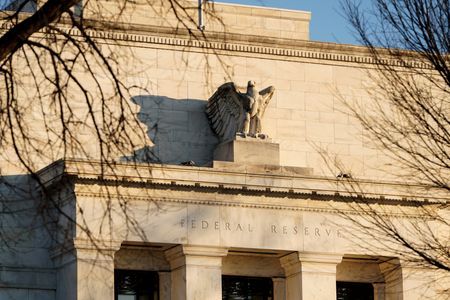By Gertrude Chavez-Dreyfuss
NEW YORK (Reuters) – Bond investors are expecting the Federal Reserve this week to temper the market’s conviction that U.S. interest rates will be cut early next year, even as portfolios get positioned for lower yields later in 2024.
Many portfolio managers have reduced long-duration bets to be more neutral on their bond positions, at least in the short term. Going long duration against a benchmark reflects expectations U.S. yields will fall because the Fed will cut rates.
Investors widely expect the Fed to hold interest rates steady on Wednesday but do not expect it to signal a shift from its tightening policy stance. According to a Reuters poll of economists, the Fed will keep rates unchanged until at least July, later than earlier thought.
In contrast, federal funds futures, the most straightforward measure of determining where traders believe the Fed’s benchmark overnight rate will be at any given time, lowered the odds of a rate cut in March on Friday, pricing in about a 46% chance, from 64% a week ago following a stronger-than-expected U.S. payrolls report.
Futures traders still saw a 79% chance in May, according to the CME’s FedWatch, but that was also down from 90% a week earlier.
Fed Chair Jerome Powell had said, in a Dec. 1 speech, that while the target rate is “well into restrictive territory,” the Fed is prepared to tighten policy further if deemed appropriate.
“There’s a real disconnect between what the Fed says and what they would like to see in terms of tighter financial conditions and what the market is doing,” said John Velis, head of U.S. macro strategy, at BNY Mellon in New York.
“What that means is that Dec. 13 is going to be a hawkish meeting. I don’t think the Fed will announce a pivot. You may see the dots push back against market pricing for early rate cuts,” referring to the Fed’s closely followed dot plot, which comes out four times a year and graphs policymakers’ rate projections.
Recent U.S. economic numbers have shown a resilient economy despite aggressive rate hikes since March last year.
Friday’s U.S. non-farm payrolls, for example, showed a still-robust labor market, creating 199,000 new jobs in November, beating consensus expectations and rising from the previous month. The unemployment rate also slipped to 3.7%.
U.S. inflation is slowing but is still a ways away from the Fed’s 2% inflation target.
BIG BOND RALLY
With investors anticipating Fed rate cuts, investors bought Treasuries, pushing 10-year yields 78 basis points (bps) lower since November, and two-year yields down roughly 49 bps.
The rapid decline in yields has made “financial conditions looser than they otherwise would have been,” said James Camp, managing director of fixed income and strategic income, at Eagle Asset Management.
That was a reversal from late October when the 10-year yield hit 5%. Market participants reckoned at the time that the Fed may not be as aggressive in raising rates because the bond market was doing the job for them by pushing yields higher.
“We now have the mirror opposite of that,” Camp said. “It’s going to be interesting to see if there’s a hawkish dialogue from the Fed because I think they need to do that if they really want the economy to continue to slow.”
FROM LONG TO NEUTRAL, FOR NOW
With asset managers betting on “higher-for-longer” rates at least until the summer, their portfolios have become more neutral or closer to their benchmark, from being long duration.
Duration, expressed in years, measures how much a bond’s price will move when the Federal Reserve changes interest rates.
“We were at the longest duration a couple of weeks ago,” said Andrew Szczurowski, head of agency mortgage-backed securities and portfolio manager at Morgan Stanley Investment Management.
Szczurowski said with the 80-90 basis point drop in yields, “we’re getting closer to neutral.”
The ultimate goal, however, is still to extend duration as the Fed will eventually cut rates. When the Fed embarks on an easing cycle, longer-duration securities tend to rally.
“We see the beginnings of recession actually hitting in the second quarter and we expect the Fed to cut at the back half of the year,” said Eagle’s Camp.
(Reporting by Gertrude Chavez-Dreyfuss; Editing by Alden Bentley and Lisa Shumaker)

